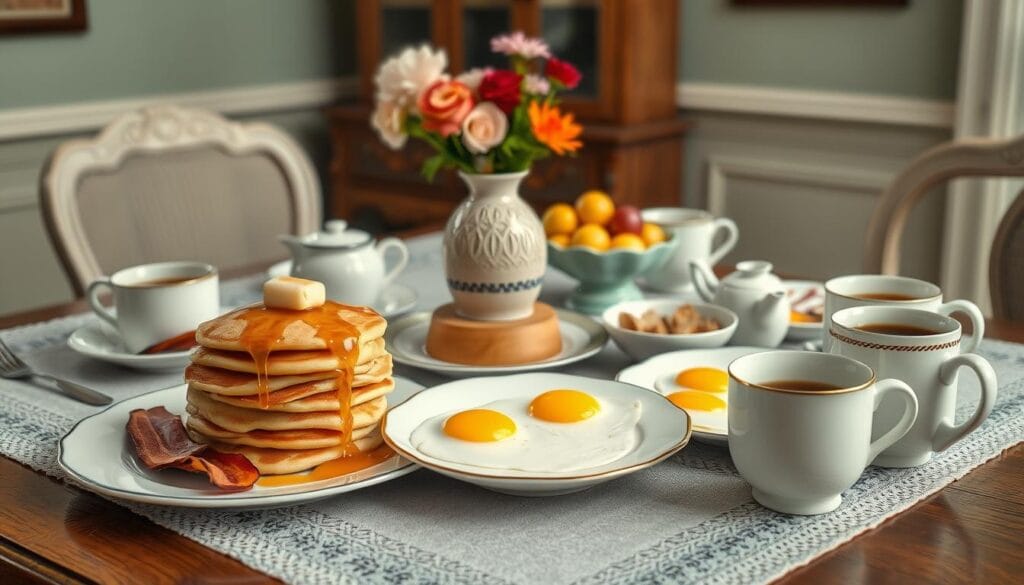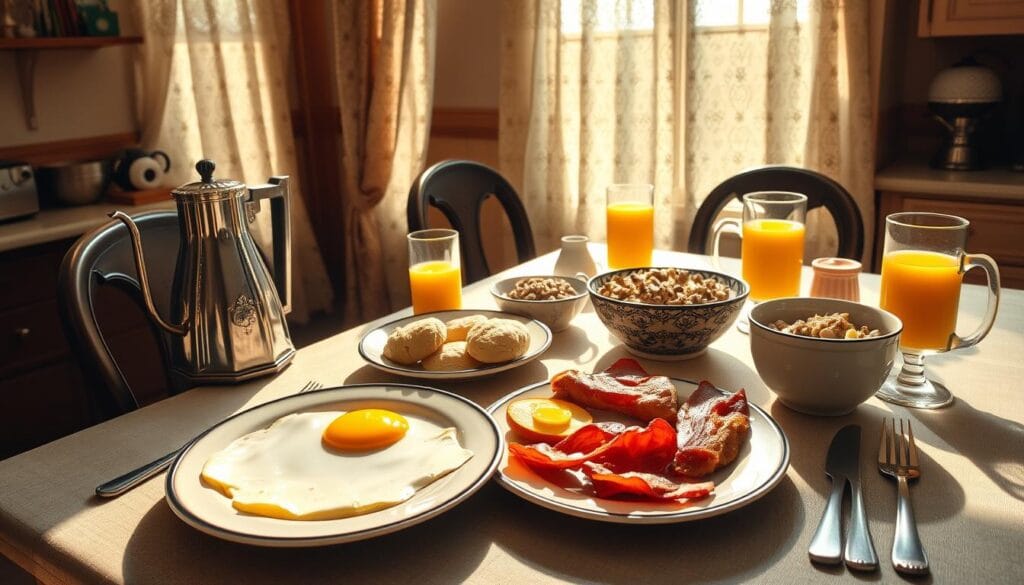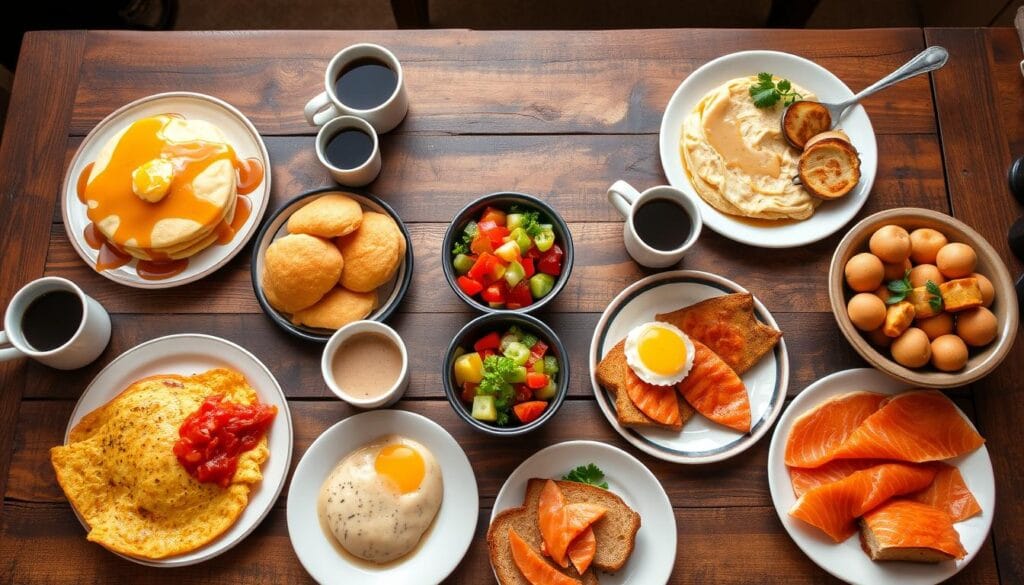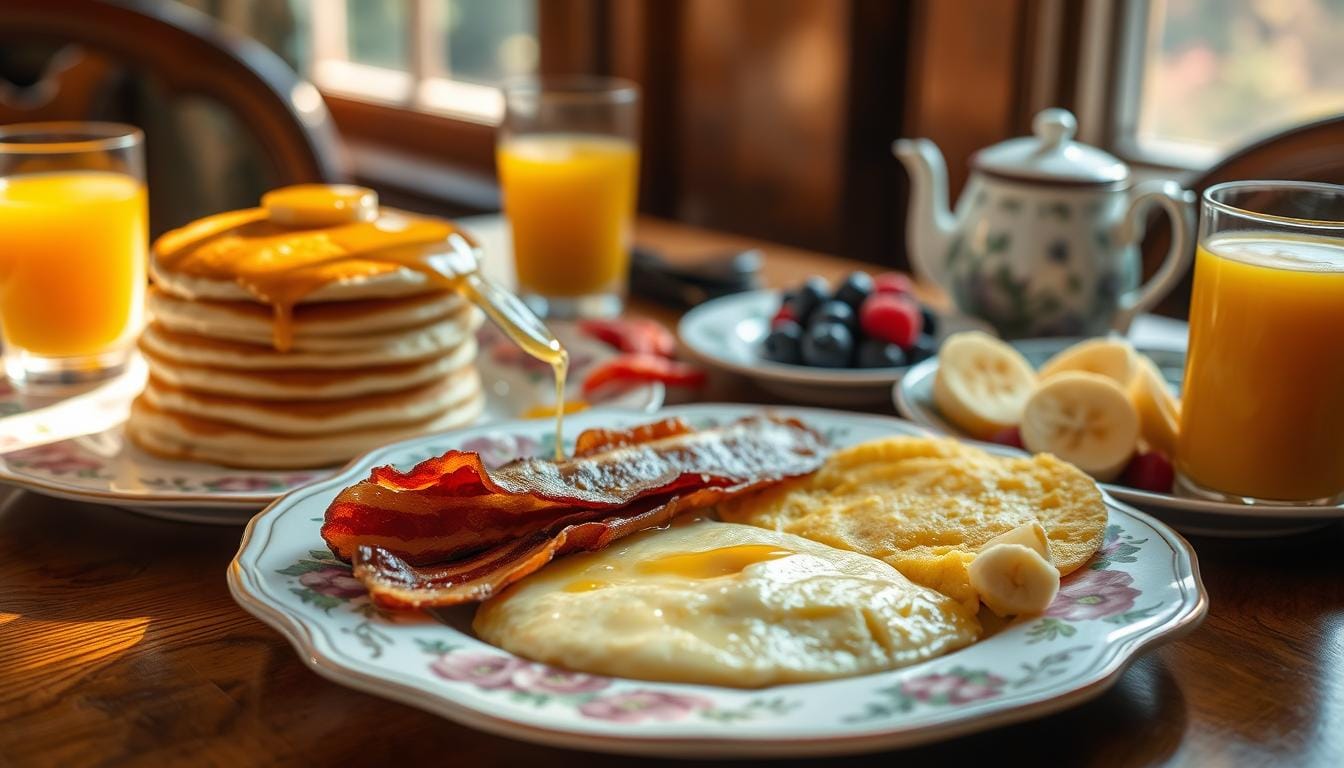Exploring American breakfasts in the 1920s, you might ask, what was a typical breakfast in 1920? This era saw big changes in breakfast, thanks to new cereals and science. Breakfasts featured cereals, eggs, bread, and fruit, reflecting the variety of American breakfasts in the 1920s.
Breakfasts in the 1920s often included soft-boiled eggs, toast, coffee, and orange juice, marking a shift towards a more “Continental” style. As you delve into American breakfast history, you’ll discover how what was a typical breakfast in 1920 reflected broader cultural and culinary changes. The rise of cereals and new foods made breakfasts in the 1920s both unique and fascinating..
The American Breakfast Table in the Roaring Twenties
The 1920s saw big changes in American society, affecting breakfast habits. New appliances like refrigerators and toasters made cooking easier. With more money, people could try different breakfast foods.
The culture of the 1920s also shaped breakfast. New technological advances brought new foods and ways to cook. For example, electric appliances helped prepare fresh ingredients. This mix of local produce and new trends led to unique recipes at hotels like the Edgewater Hotel.
Popular breakfast foods included baked goods and fresh orange juice. Beef sausage and eggs became trendy, even though locals didn’t eat them often. Guests preferred traditional foods over Post cereals, which were not yet popular.

The following table highlights some of the key breakfast foods and beverages of the 1920s:
| Food/Beverage | Description |
|---|---|
| Baked Goods | Made with eggs, sugar, and spices |
| Fresh Orange Juice | Squeezed from oranges grown on hotel properties |
| Beef sausage and Eggs | Introduced as a trend, despite not being a staple for locals |
| Post Cereals | Limited selection available, not yet popular among guests |
The American breakfast table in the Roaring Twenties was influenced by many factors. Social change, technology, and culture all played a part. The foods and drinks of the time show the era’s unique history and culture.
Common Breakfast Foods of the 1920s
In the 1920s, breakfast changed to focus on quick and simple meals. People wanted to make mornings easier. Cereals, both hot and cold, were big hits. Corn Flakes and Shredded Wheat were favorites, making mornings quicker.
Eggs were also a big deal, often paired with toast and hash browns. New appliances like refrigerators and toasters helped in cooking and storing food. Breads and spreads, like jam and honey, added sweetness to breakfast.

- Cold cereals like Corn Flakes and Shredded Wheat
- Hot cereals like oatmeal and cream of wheat
- Eggs, often served with toast, hash browns, and other side dishes
- Breads and spreads, like jam and honey
The 1920s breakfast was all about being easy and simple. It was a key part of the day, and people sought efficiency. By trying these foods, you can feel the past and begin your day well.
Regional Breakfast Variations Across America
As you travel across the United States, you’ll find unique breakfast habits and customs. Each region has its own special breakfast traditions. From the South to the North, every area has its own flavor.
In the South, breakfasts are big and filling. You’ll find dishes like grits, biscuits, and gravy. In the North, breakfasts are lighter, with options like toast, cereal, and fruit. These differences show how diverse American breakfast customs are.
Some notable regional breakfast habits include:
- Chicken and waffles in the South
- Fried eggs and Beef sausage in the Midwest
- Avocado toast in California
These regional breakfasts reflect local tastes and highlight breakfast’s role in American culture. Exploring these differences helps us appreciate the variety of breakfast habits across the United States.

Whether you’re in the South, North, or somewhere in between, there’s a unique breakfast waiting for you. So, embark on a culinary journey across America. Discover the diverse breakfast customs that make each region special.
| Region | Breakfast Dish |
|---|---|
| South | Chicken and waffles |
| North | Toast and cereal |
| Midwest | Fried eggs and beef sausage |
What Was a Typical Breakfast in 1920 for Different Social Classes?
Exploring the trends of the 1920s reveals significant differences in breakfast habits based on income levels. The wealthier individuals enjoyed more elaborate breakfasts, often consisting of eggs, beef sausage, toast, and fruit, served early as part of a structured daily routine.
In contrast, people whose income was below the poverty threshold or those with low incomes had simpler meals, such as porridge or bread with tea. Coffee or tea was common among wealthier households, but only about 35% of low-income families had access to these beverages in the morning. The 1920s, however, saw improvements in food availability for all, driven by cultural changes.
- About 60% of middle and upper-class families ate breakfast together at the table.
- Only about 30% of working-class families did the same.
- Almost 40% of working-class kids skipped breakfast because they were in a hurry or didn’t have food.
These numbers show how trends in breakfast varied by social class in the 1920s.
The Role of Convenience Foods in 1920s Breakfasts
The 1920s saw a big change in American food, moving towards convenience. Packaged cereals and canned goods made meals quicker and easier. This change was big for breakfasts and shaped American food history.
In this time, convenience was key in food choices. Many homes chose quick meals. Electric refrigerators, though pricey, helped keep food fresh longer, saving time.
By 1920, people spent 44 hours a week on food prep and clean-up. This showed the need for quicker, easier food options.
Some notable convenience foods from then include:
- Baby Ruth Candy Bar
- Wonder Bread
- Frozen vegetables, fruits, fish, and meats by Birdseye
These items met the demand for fast, easy breakfasts. American breakfasts became simpler, with trains and boats helping standardize menus.
The rise of convenience foods in American breakfasts is interesting. It shows how tastes and preferences changed. Exploring 1920s breakfasts reveals a mix of old and new, showing American cuisine’s dynamic nature.
| Year | Convenience Food | Impact on Breakfast |
|---|---|---|
| 1920 | Packaged cereals | Increased convenience and efficiency |
| 1925 | Electric refrigerators (Frigidaire) | Improved storage and longer storage of perishable food |
| 1930 | Frozen foods (Birdseye) | Expanded options for quick and easy meal solutions |
Breakfast Table Settings and Etiquette
Breakfast table settings and etiquette are key to a great dining experience. In many cultures, how we set the table is as important as the meal itself. Some use fine china and silverware, while others prefer a casual vibe.
The right tableware can really set the mood. Fine linens, elegant glassware, and sterling silver bring elegance to the table. On the other hand, earthy tones and natural materials create a cozy feel. The goal is to make the table warm and welcoming, encouraging everyone to feel connected.
Good manners are also vital at breakfast. This means using napkins, waiting for everyone to be served, and talking nicely. These simple steps make breakfast enjoyable for everyone. Embracing breakfast traditions adds richness to our daily meals.
Service style is another important part of breakfast etiquette. Some cultures serve meals family-style, while others serve each person individually. Understanding these differences helps create a welcoming breakfast table. It shows respect for the culture and tradition of the community.
Popular Breakfast Beverages
In the 1920s, morning habits included a variety of breakfast drinks. Coffee and tea were favorites, often enjoyed with meals. The choice of drink varied based on personal taste, social class, and culture.
In the U.S., coffee was a top pick for breakfast. In Europe, hot chocolate was a hit, loved by kids. Orange juice and grapefruit juice were also becoming popular. In India, lassi, a yogurt drink, was a favorite, perfect for hot summer days.
Here are some popular breakfast drinks from around the world:
- Coffee: a common breakfast drink in many cultures
- Tea: a popular choice in the United States and Europe
- Hot chocolate: a prevalent breakfast drink in Europe
- Orange juice: widely consumed in North America
- Grapefruit juice: sometimes consumed at breakfast in the United States
Breakfast drinks varied greatly by region and culture. Learning about these habits gives us a peek into 1920s daily life. Exploring these drinks helps us appreciate the unique customs and traditions of that era.
| Breakfast Beverage | Region | Popularity |
|---|---|---|
| Coffee | United States, Europe | High |
| Tea | United States, Europe | High |
| Hot Chocolate | Europe | Medium |
| Orange Juice | North America | High |
| Grapefruit Juice | United States | Medium |
The Impact of Advertising on 1920s Breakfast Choices
Advertising played a big role in shaping breakfast choices in the 1920s. Companies like Kellogg’s and General Mills used ads in magazines and on the radio, featuring catchy slogans and memorable characters. This had a significant impact on American food history. Companies like Kellogg’s revolutionized breakfast through advertising, emphasizing health, efficiency, and convenience. Their campaigns shaped public preferences for products like Post Cereals.
In the 1920s, trends in breakfast ads focused on quick and easy meals. With industrialization, people had less time for big breakfasts. Breakfast cereals like Toasted Corn Flakes and Grape-Nuts became very popular, with ads promoting the idea that starting your day with a simple, easy meal was essential.
Magazine Advertisements
Magazine ads were a big part of 1920s breakfast ads. Companies used bright pictures and catchy slogans to grab attention. For example, Kellogg’s said “Breakfast is the most important meal of the day” to promote Corn Flakes.
Radio Promotions
Radio ads were another way to reach people. With radio’s rise in the 1920s, companies could promote their products widely. General Mills, for instance, used radio to push their breakfast cereals as nutritious and convenient.
In the 1920s, ads had a big impact on breakfast choices. As American life got busier, people wanted quick, easy breakfasts. Ads from Kellogg’s and General Mills helped shape American breakfasts. Their influence is seen in today’s breakfast trends.
Conclusion: The Legacy of 1920s Breakfast Traditions
The 1920s redefined American breakfasts, blending innovation with tradition. The rise of convenience foods, regional diversity, and advertising left a lasting impact. Today’s morning routines reflect this legacy, with classics like eggs and toast continuing to dominate breakfast tables. Exploring the history of breakfast offers a deeper appreciation for its evolution. For more insights into early morning traditions, visit Who Invented Eating Breakfast?.
FAQ
Q: What was a typical breakfast in 1920?
A: In the 1920s, breakfasts in America were varied. They included cereals, eggs, bread, and fruit. These foods were easy to digest. Modern appliances made cooking breakfast easier for everyone.
Q: How did social changes affect breakfast habits in the 1920s?
A: The 1920s brought big changes in the US. Modern appliances and a growing middle class changed breakfasts. People had more choices and variety in their morning meals.
Q: What were the common breakfast foods of the 1920s?
A: Breakfast cereals, both hot and cold, were big in the 1920s. Eggs were also popular, often with toast, hash browns, and more. Breads and spreads like jam and honey were common too.
Q: How did breakfast customs vary across different regions of the United States in the 1920s?
A: Breakfasts in the 1920s varied by region. In the South, breakfasts were often big and filling. In the North, they were lighter and simpler.
Q: What was a typical breakfast for different social classes in the 1920s?
A: Breakfasts in the 1920s varied by social class. The working class ate simple meals like oatmeal or eggs. The middle class enjoyed pancakes or waffles. The upper class had fancy breakfasts, like champagne and caviar.
Q: How did convenience foods impact American breakfasts in the 1920s?
A: Packaged cereals and canned goods became popular in the 1920s. They made breakfast easier to prepare, changing what people ate.
Q: What were the typical breakfast table settings and etiquette in the 1920s?
A: Tableware, manners, and service in the 1920s showed the culture and values of the time. Each reflected the unique spirit of the era.
Q: What were the popular breakfast beverages in the 1920s?
A: Coffee and tea were favorites in the 1920s. What people drank depended on their taste, class, and background.
Q: How did advertising impact breakfast choices in the 1920s?
A: Ads by companies like Kellogg’s and General Mills were big in the 1920s. They used catchy slogans and memorable characters. Advertising greatly influenced breakfast choices, shaping American food history.

